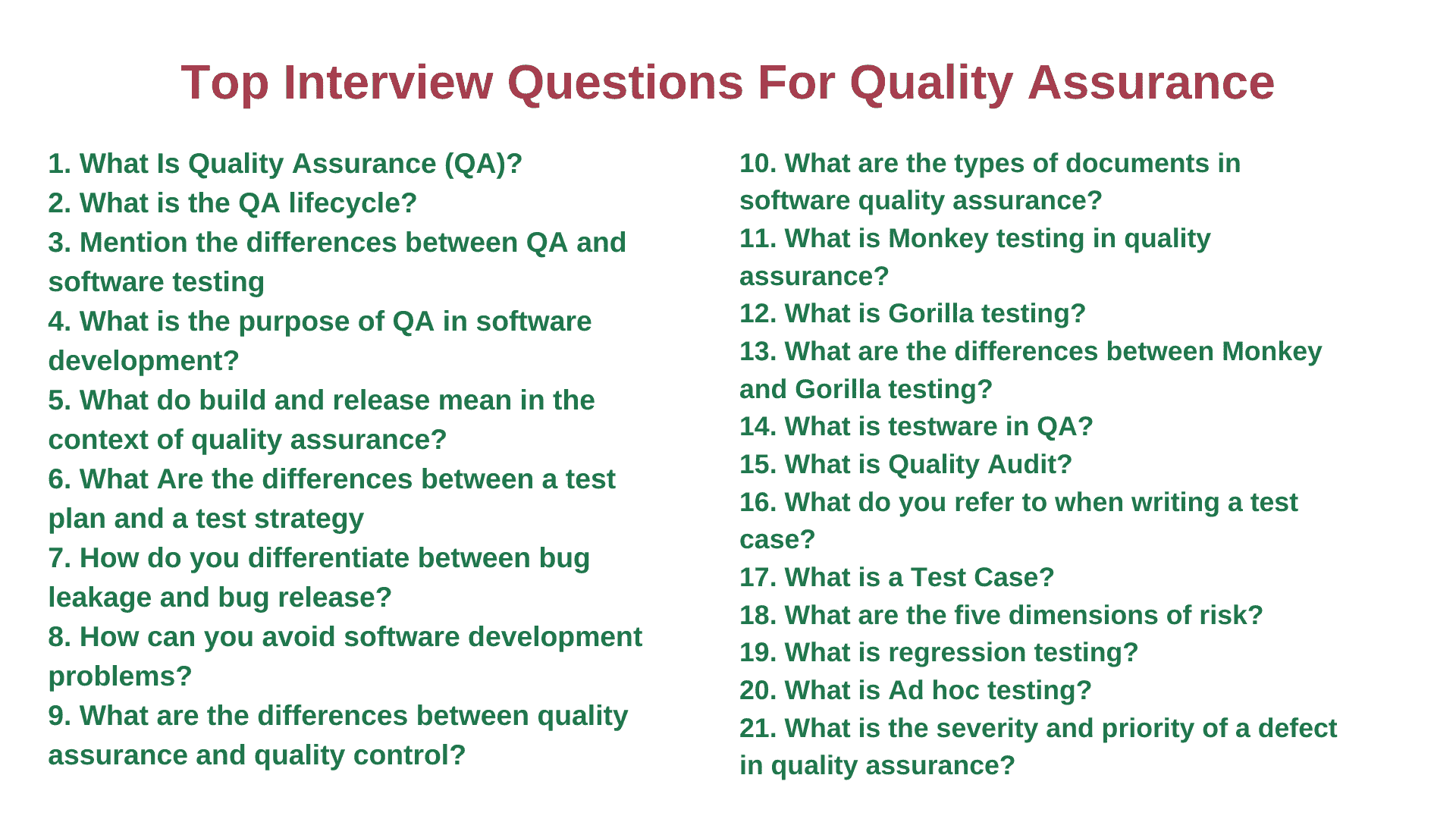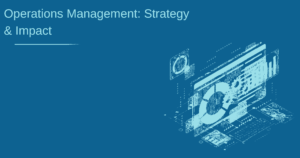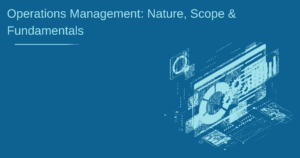Many things affect the sales of products and services. Price, appearance, availability, quality, etc., are the factors that a customer looks at when purchasing a product. Of all these, quality is most important because that ensures good working and life of the item. In a competitive market, companies must be careful about quality because it affects sales and the company’s reputation. We will see how companies ensure quality before we look at the interview questions for quality assurance. To know that, we must understand what quality assurance is.
A lot is taught about quality assurance in the Advanced Executive Certificate Course In Supply Chain Strategy And Operations Management, as it is one of the operations manager’s responsibilities. You can learn more about this course on our website.
What Is Quality Assurance?
Quality Assurance is a statement that companies make assuring customers of the quality of their products. But it is not an assurance given without any backing. All organisations perform activities to ensure that the product or service satisfies customers’ requirements. It ensures that customers will be happy and purchase the product again or recommend it to their friends. The QA system helps companies earn customer confidence and improve their credibility. We will see more about these activities when we answer the top interview questions for quality assurance officials.
A quality assurance process also helps the company improve its work methods and efficiency. The International Organisation for Standardisation has given the procedure for implementing QA. Most companies use these guidelines to ensure they sell only quality products and services. QA practices enable companies to compete effectively in the market. Because of its importance, most organisations have a separate QA team. Those interested in this career must be thorough with the system and must be able to answer interview questions for quality assurance convincingly. This article aims to familiarise prospective candidates with common questions and their answers.
Why Learn The Interview Questions For Quality Assurance?
Companies use interviews to finalise their candidates. That is where they can understand how good the person is and how suitable they will be for the organisation. So anyone wanting to be hired must be able to answer questions quickly and impress the interview panel. Most of us spend hours rehearsing the interview and preparing well to impress the officials. Wouldn’t it be nice to know the most probable questions and their answers before attending the interviews? We aim to familiarise you with interview questions for quality assurance through this article.
The Advanced Executive Certificate Course In Supply Chain Strategy And Operations Management teaches you all the questions you will face in interviews and trains you to answer them convincingly. You can learn more about the course on our website.
Top Interview Questions
- What Is Quality Assurance (QA)?
It is a certain question in any QA interview, and it is best to be prepared to answer this well. QA is a set of activities performed by experts in the field to ensure that the product meets all the quality parameters promised by the company.
- What is the QA lifecycle?
The quality assurance life cycle includes four phases and is known as the PDCA Cycle. PDCA stands for Plan Do Check Act.
Plan – The company must plan and develop objectives to ensure that the final product conforms to the quality standards promised to customers by the firm.
Do – In this phase, the QA team develops and process it. They also “do” changes to the process to ensure that the product meets the quality parameters set by the firm.
Check – During this stage in the QA life cycle, the team monitors, modifies and checks to see if the processes achieve the desired goals. They check the process to ensure it doesn’t miss any defects during testing.
Act – Testers take the necessary steps to improve the process in this stage.
- Mention the differences between QA and software testing
| Quality Assurance Software | Software Testing | |
| Activities | All activities in QA aim to ensure that the software meets all the user requirements | It is done to ensure that the actual results match the expected results and that there are no bugs. |
| Activities | Involves the implementation of processes, procedures and standards | Includes only the verification of testing |
| Orientation | It is a process-oriented activity that checks processes to ensure that a customer gets a high-quality product. | It is a product oriented activity aimed at testing the functionality of the software |
| Type Of Activity | Preventive | Corrective |
| Objective | Its objective is to make sure that the customer gets a quality product | The main objective of software testing is to find and eliminate bugs in the software. |
- What is the purpose of QA in software development?
It is another one of the interview questions for quality assurance that you can expect when you attend interviews in a software company. It is in these companies that QA plays a very major role.
- Defining the objectives of testing and the ways to achieve them.
- Develop a test strategy based on the specifications and timeline of the project.
- Completing the tests using the correct method and documenting the failures in the test.
- Finding the root cause of the failures by analysing the flaws.
- Repairing the defects so that they don’t affect the quality of the final product.
- Using a bug-tracking system to communicate defects to the developers.
- What do build and release mean in the context of quality assurance?
Build – It is the version of the software that the developers hand over to the testing team to check for defects. A build can be a complete programme or one which has some new features added to it. It is then given to the testers to ensure that the software works with the new feature. There can be many builds for the same application.
Release – It is the final application that has completed development and testing. It is the final product that reaches the customer after testing for defects and correcting them. A release may have gone through several builds and testing.
- What Are the differences between a test plan and a test strategy
Test Plan
- It specifies a software testing process’s scope, purpose, approach and emphasis.
- The test plan includes the test plan ID, features to be tested, testing procedure, testing tasks, criteria for features passing or failing, test deliverables, responsibilities and schedule.
- The test plan contains the specifications of the testing process.
- A testing manager or a lead executive creates the test plan that specifies the how, when, who and what of the test.
- Test plans are likely to change after the team creates them.
- This document is prepared to identify the risks by determining the potential issues and dependencies.
- Test plans can exist by themselves.
- It is established at the project level.
Test Strategy
- Test strategy is a set of guidelines mentioning how to develop tests and how they must be carried out.
- The components of the test strategy are objectives and scope, documentation formats, test methodologies, team reporting structure, and client communication strategy.
- Test strategy lays down the general approaches.
- The project manager implements the test strategy. It mentions the approach to be used and what modules to test.
- You cannot change the test strategy once you create it.
- It is a long-term approach. You can use information unrelated to the project to create the test strategy.
- It is seen as a component of the test plan in small projects.
- Test strategy is created at the organisational level and can apply to various projects.
- How do you differentiate between bug leakage and bug release?
Bug Leakage – A bug leakage happens when a bug is detected by an end user instead of it being found out during earlier versions or builds of the application. It is a case where the bug existed during testing and was not found by the tester.
Bug Release – When an application is released with a set of known bugs or defects, it is known as a bug release. The company knows that these bugs exist in the application. But as they are not a high priority, the organisation doesn’t spend time or money removing them. It is mentioned in the release note of the software.
Also Read: What is Order Management? A Comprehensive Guide
- How can you avoid software development problems?
- Set up the requirement criteria with the development requirements mentioned clearly, completely and with everyone’s consent.
- Have a realistic schedule with enough time for planning, designing, testing, fixing bugs and retesting.
- Start the testing immediately after the completion of one or two modules.
- Use of group communication tools.
- Use rapid prototyping during the design phase to help customers understand what they can expect.
- What are the differences between quality assurance and quality control?
One of the top interview questions for quality assurance is how it differs from quality control. Every aspirant to a job in QA must know the differences.
Quality Assurance
- QA is a method of assuring the customer that the product will meet the specified quality parameters.
- The goal of QA is to avoid defects.
- It helps to keep track of quality.
- Running the software is not a necessity.
- QA is a proactive measure.
- It is a method for producing correct deliverables.
- There is QA in the entire software development process.
- It establishes standards and processes for achieving client expectations.
- QA is done before quality control.
- It is a low-level activity that helps to find defects that quality control cannot.
- QA is a verification activity as it guarantees that everything has been done correctly.
- QA uses the statistical technique called Statistical Process Control (SPC).
Quality Control
- Quality Control aims at achieving the desired level of quality.
- QC is done to detect and correct flaws in the software.
- It is a validation process for verifying quality.
- Running the software is essential for quality control.
- QC is a reactive measure.
- Companies use it to ensure that the deliverables are correct.
- Quality control is done during the entire software testing process.
- It ensures that developers follow the standards and processes established in QA.
- QC is a high-level activity aimed at detecting defects that QA cannot find.
- It is a validation activity to ensure that everything is done as required.
- It uses a statistical technique called Statistical Quality Control (SQC)
- What are the types of documents in software quality assurance?
Requirement Document – It lists all the functionalities that need to be present in the software. This document is prepared with the support of various officials like developers, testers, and business analysts. etc.
Test Metrics – It lays down the parameters that determine the effectiveness and quality of the testing process.
Test Plan – This document defines the strategy that the company will use to test a product. It contains details like resources for testing, the test environment and the schedule for the test.
Test Cases – It gives details of the steps and conditions that will be used for testing. It is done to ensure that all functionalities are working properly. There are different types of test cases logical, error, functional, negative, physical and UI.
Traceability Matrix – It is a table that maps the user requirements with test cases. This helps to make sure that all test cases are covered so that the testing doesn’t miss any functionality.
Test Scenario – This document contains the collection set of test cases that helps the team to determine the positive and negative aspects of the project.
- What is Monkey testing in quality assurance?
This is a type of testing where there are no predefined test cases. The tester inserts any random input into the software to see how it reacts and whether it crashes. The goal of this method of testing is to use experimental ways to bring out the application’s defects and flaws. It doesn’t need the creation of test cases. Monkey testing can also be automated by creating a programme that will insert random inputs into the software. There are two types of Monkeys used for this testing.
Smart Monkeys – They are people who know about the application and are aware of which page will direct to which other pages. They also know whether they are feeding valid inputs or not. If they find any faults, they will report them as bugs. They also know about buttons and menus.
Dumb Monkeys – These are individuals who are completely unaware of the application or how pages will route them. They give random inputs without knowing the beginning or end of the application. Despite their ignorance about the application, they can uncover faults like environmental or hardware failures. They have very little knowledge about the application’s functions or user interface.
- What is Gorilla testing?
Gorilla testing is a method of testing where a module is frequently tested using various random inputs to ensure that it functions well. Because of its pattern, this method is also called torture testing, fault tolerance testing and frustrating testing. It is a manual testing method where developers and testers collaborate to evaluate the functionality of a module.
- What are the differences between Monkey and Gorilla testing?
Monkey Testing
- It is a method of testing to evaluate the behaviour of a software system by giving random inputs to see if it crashes. There are no test cases for this type of testing.
- The primary aim of Monkey testing is to see if the application will crash or not.
- It is a random testing method without any test cases.
- Monkey testing is carried out over the entire system.
- This is primarily used in system testing.
- Random testing, Fuzz testing and Stochastic testing are the other names for Monkey testing.
Gorilla Testing
- This testing is done frequently on a module to check the operations of the module and ensure there are no defects.
- Gorilla testing is done to check whether a module functions properly or not.
- It is a manual testing method that is frequently done on a module.
- Only a few selected modules undergo this testing.
- Unit testing primarily uses Gorilla testing.
- Torture testing, Fault Tolerance testing and Frusting testing are its other names.
- What is testware in QA?
It is a set of software programmes created exclusively for testing software, especially in the automation of testing. It is a combination of all utilities and application software that work together to test an application but don’t contribute to its operational purpose. It is not a static configuration but only a working environment for applications or their portions. It includes everything created during the testing process needed to plan, develop, and execute tests, like documentation, scripts, inputs, expected outcome and set-up.
Testware also includes clear-up processes, files, databases, environment and other tools used during testing. Verification and validation testing methodologies are used in creating testware. Like software programmes, it also contains codes, binaries, test cases, test plans and test reports. Testware should be maintained carefully under the direction of a configuration management system.
Also Read: What Is Inventory Management? 15 Effective Techniques
- What is Quality Audit?
A quality audit is a way to determine whether the process that is used and implemented in the testing process is defined and complies with the specifications to ensure a generated product.
- What do you refer to when writing a test case?
- Specifications of functional requirements.
- A document explaining the requirements.
- Wireframes
- Use cases
- User stories
- Acceptance criteria
- User acceptance testing test case.
- What is a Test Case?
A test case is a set of activities performed to make sure that a feature or operation of the software is working properly. It is a collection of test procedures, data, preconditions, and postconditions created for a specific test scenario to verify a requirement. A test case contains specific variables that the tester can use to compare actual and desired outcomes to check if the software meets customer needs. This is one of the interview questions for quality assurance that you can prepare to impress the interview panel.
- What are the five dimensions of risk?
Schedule – Unrealistic timelines like expecting to create a large piece of software in a single day.
Client – Unclear, changing or ambiguous requirements from the client.
Human Resource – Not having enough staff members with the necessary expertise.
System Assets – The outcome will be unfavourable if the necessary hardware and software tools and licences cannot be acquired.
Quality – You may not get the expected quality due to various factors like lack of resources, changing requirements and strict delivery timelines.
- What is regression testing?
This is one of the interview questions for quality assurance asked of experienced candidates. Regression testing is performed to ensure that a software update will not change the way an application functions. It is a complete or partial repetition of testing done earlier to ensure that functionalities are not affected. It helps to ensure that the old codes function properly after doing code modifications. Selecting the test cases for regression testing is not easy, as proved by various customer complaints after modifications are made.
- What is Ad hoc testing?
It is a causal method of software testing that does not adhere to any established procedures like test cases, test plans and requirement documents. It is a procedure done on an application after formal testing is over. Though it is similar to monkey testing, ad hoc testers must have deep knowledge of the software they are testing.
- What is the severity and priority of a defect in quality assurance?
Severity refers to the seriousness of the defect and how much it can affect the working of the software. Priority refers to the order in which defects must be attended to.
You can learn more questions and answers in the Advanced Executive Certificate Course In Supply Chain Strategy And Operations Management. More details about the course are available on our website.
Conclusion
A good quality assurance strategy ensures that the final product meets the requirements of the client and has no defects. An in-depth knowledge of testing methods and how they must be used will help ensure a high-quality product. As a QA aspirant, you will be familiar with all technical aspects. However, it is crucial to complete the interview successfully if you want to be considered for the job. Familiarising yourself with the above questions and answers will help you get over the interview successfully.
More Information:
Why Do Businesses Need An Operations Strategy?
What is Process Improvement? Why is it important?




























